A Multiplicity of Narratives
Scott Gabriel Knowles writes that “…conflicts over authority, expertise, memory, and finally the attribution of responsibility suffuse the history of disaster in the United States,” (2003, 11). This suggests that no disaster has a singular narrative. Rather, the numerous stories, testimonies, and experiences that emerge following a disaster are likely to differ from another. Depending on the disaster, these differences may prove minute or enormous. In some cases, alternative representations may even prove contradictory and irreconcilable. The Dust Bowl provides a particularly compelling example of Knowles’ statement above primarily because it defies multiple categories of disaster. The crisis in the Great Plains proved at once a sequence of swift and dramatic dust storms, and a slower, more drawn-out disaster. The Dust Bowl also bends our understanding of a natural, or ecological disaster. The Dust Bowl thus defies categorization in at least two ways, making it a challenge to represent and creating an opportunity for the existence of diverging narratives.
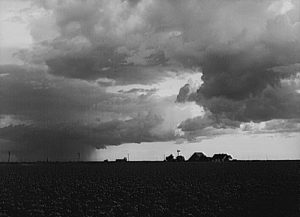

Slow or Spectacle?
Although many disasters are comprised of either a single spectacular event or a slower constant threat, the Dust Bowl evades this kind of categorization. The signature events of the Dust Bowl, the dust storms, were dramatic, relatively fast, and relatively localized. They came in two varieties: the more common sand blows and the rarer black blizzards. The latter were particularly dramatic; they could reach heights of 8000 ft and inspired many photographers to document their impressive form (Worster 2004, 14). These storms also caused graphic damage to both land and humans. During the storms, the air became so thick with dust that people could not see beyond a tiny radius and frequently got lost if they were outside. Farm animals, and children sometimes suffocated because the winds and the dust were so intense. On one occasion, a black blizzard blew out the entire Nebraska wheat crop—about 5 million acres in total (Worster 2005, 18). Another storm, the one frequently described as the worst of the entire decade, was termed “Black Sunday.” The dramatic elements of these storms mean that the Dust Bowl in some ways has much in common with spectacle disasters. However, the dirty thirties were also much more than a spectacle disaster.
In hindsight, many historians consider the Dust Bowl an exceedingly slow disaster, particularly with regards to its origin. In fact, several emphasize the role of capitalism in the disaster’s making. Hannah Holleman takes this view: “An honest and historically informed look at the present situation reveals the imperial system of capitalism as the primary driver of dust-bowlification,’” (Holleman 2018, 22). Other corroborate this position, including Donald Worster. He writes about, “a social system, a set of values, [and] an economic order” that summarizes as capitalism (Worster 2004, 5). Approaching the disaster from this perspective yields a timeline of the disaster that extends well beyond a decade. While other causes, such as droughts, are more temporally specific, capitalism emphasizes how the origin of the disaster, in addition to the event itself, were slow and systemic. Capturing the essence of the Dust Bowl thus requires addressing the generally clashing qualities of slow and spectacle within the disaster.
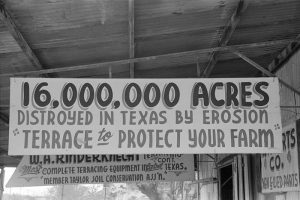
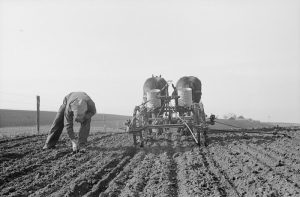
A Natural or Nonnatural Disaster?
The Dust Bowl likewise evades easy categorization because its causes are both ecological and human in nature. Even historians like Worster who tend to emphasize the non-natural admit that drought was a “necessary factor”; Worster writes that, “Without the abrupt drop in precipitation the southern plains would never have become so ravaged a country,” (Worster 2004, 42). Yet to blame the entirety of the disaster on ecological causes is an oversimplification. At the other extreme, some historians completely obscure the ecological cause of the disaster: “…the Dust Bowl was not a natural disaster; it was a disaster caused by what people did to nature,” (McDean 1986, 118). In reality, some combination of ecological and anthropogenic factors combined to produce the event. Recent climate modeling has demonstrated how human-induced land degradation likely worsened the dust storms and amplified the effects of drought (Cook et al. 2009, 4998). Especially with regards to nature, the Dust Bowl becomes difficult to describe as it contains remarkable complexity that should make us question how we understand natural disasters.
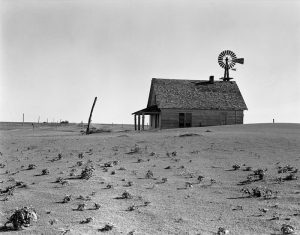
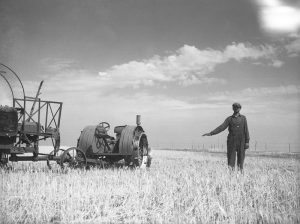
Reconciling the Representations
A wide range of sources exemplify the multiplicity of narratives that emerges from this multifaceted disaster. These include official reports, individual testimony, books by historians, government-made films, novels including The Grapes of Wrath, and documentaries like that of Ken Burns. These sources might disagree on everything from the relative importance of drought or capitalism to the very geography of the Dust Bowl. Sometimes certain sources might emphasize particular aspects of the narrative out of self-interest or personal bias. Steinbeck, for example, uses the Joad family in the Grapes of Wrath to advance a social critique that relies on a slow and capitalist understanding of the event. Meanwhile government-produced films might highlight the ability of New Deal programs to resolve a largely ecological disaster. Other voices might let form dictate their representation. Ken Burns, for instance, relies heavily on interviews and the spectacle aspects of the disaster to tell an engaging history of the thirties. With disasters as complex as the Dust Bowl, it remains particularly important to recognize the ways in which capturing a singular narrative might prove difficult and even problematic.
Image citations, in order of appearance:
- John Vachon, Landscape with large rain clouds looming over farm buildings in the middle of a field, May 1943, photo, Victoria County, Texas, The Library of Congress, Prints & Photographs Division.
- Arthur Rothstein, The fine dirt lifted by the dust storms and blown by the winds scraped some fields to hardpan and created dunes wherever there were eddies in the wind, 1936, photo, Oklahoma panhandle, The Library of Congress, Prints & Photographs Division.
- Russell Lee, Government sign promoting land terracing to prevent erosion, April 1939, photo, Taylow, Texas, The Library of Congress, Prints & Photographs Division.
- John Vachon, Farmer inspecting soil next to planter pulled by horses in field, May 1940, photo, Jasper County, Iowa, The Library of Congress, Prints & Photographs Division.
- Dorothea Lange, Abandoned farm north of Dalhart, Texas, 1938, photo, Dalhart, Texas, The Library of Congress, Prints & Photographs Division.
- Arthur Rothstein, A farmer holds out his hand to represent how hight the wheat should be in a field, July 1936, photo, Grant County, North Dakota, The Library of Congress, Prints & Photographs Division.
